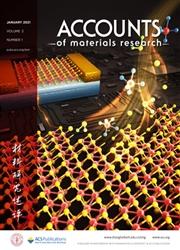Design and Development of Fire-Safety Materials in Artificial Intelligence Era
IF 14
Q1 CHEMISTRY, MULTIDISCIPLINARY
引用次数: 0
Abstract
Figure 1. (a) Previous methods for deducing mechanism and (b) our proposed novel approach for revealing the real burning behavior and flame-retardant mechanism. Figure 2. (a) Illustration of the previous structure–activity relationship theory and (b) our proposed theoretical flame retardancy model based on the flame-retardant roles. Figure 3. AI-assistant self-iterative, high-throughput, and generalizable flame-retardant material design framework. Traditional flame retardants and flame-retardant polymeric materials struggle to meet the stringent requirements of emerging areas. For instance, fire incidents involving new energy vehicles, extreme wildfires, and hydrogen fuel cells, etc. present extreme conditions with higher temperatures and greater heat flux, demanding enhanced thermal stability and heat shock resistance in flame-retardant polymeric materials. Additionally, materials used in ultrahigh-voltage electrical systems must withstand extreme voltages and large currents, necessitating improved electrical insulation and thermal stability to ensure operational safety and reliability. Some halogen-based and certain phosphorus-based flame retardants are still associated with persistent, bioaccumulative, and toxic (PBT) hazards. (25−27) Future research should prioritize the development of low-toxicity, low-pollution flame-retardant solutions that minimize environmental accumulation risks while preventing the release of hazardous gases or persistent pollutants during combustion. Traditional flame retardants are primarily derived from nonrenewable fossil resources, which conflicts with carbon neutrality and sustainability goals. Future research should explore the use of renewable biomass resources, such as polysaccharides, lignin, and proteins, to develop efficient and low-carbon flame retardants. Flame retardants are typically incorporated into polymeric materials through physical or chemical means, where incorporating flame-retardant elements often complicates waste management by limiting material reuse and increasing environmental impact. (28) Therefore, considering the recyclability of flame-retardant polymeric materials in the initial material design or the physical/chemical/biological recovery of the discarded flame-retardant polymeric materials is necessary to reduce the impact on the environment and improve resource utilization. Figure 4. AI-assistant material design framework applying to flame retardant or flame-retardant materials research. T.F. and Y.-Z.W. discussed the topic and proposed the outline, wrote the draft, and revised the manuscript. Teng Fu received his Ph.D. in polymer chemistry and physics in 2019 from Sichuan University. He joined Professor Yu-Zhong Wang’s group in 2019, and now he is a researcher at Sichuan University. His current research interests are focused on fire-safety materials, devices and apparatus. Yu-Zhong Wang received his Ph.D. from Sichuan University in 1994 and became a Full Professor of Sichuan University in 1995. He is the Director of the National Engineering Laboratory for Eco-Friendly Polymeric Materials (Sichuan)/National Engineering Research Center for Advanced Fire-Safety Materials D&A (Shandong), which he founded. His research interests are focused on fire-retardant and functional polymeric materials, along with biobased and biodegradable polymers, as well as recycling and upcycling of polymeric materials. This work is financially supported by the National Science Foundation of China (U24A6004), the Fundamental Research Funds for the Central Universities, the 111 project (B20001), National Key Laboratory of Advanced Polymer Materials (Grant No.sklpme2024-2-02), and the Institutional Research Fund from Sichuan University (2021SCUNL201). This article references 28 other publications. This article has not yet been cited by other publications.

人工智能时代消防安全材料的设计与开发
图1所示。(a)前人的机理推导方法和(b)我们提出的揭示真实燃烧行为和阻燃机理的新方法。图2。(a)说明先前的构效关系理论和(b)我们提出的基于阻燃作用的理论阻燃模型。图3。人工智能辅助自迭代、高通量、可推广的阻燃材料设计框架。传统的阻燃剂和阻燃高分子材料难以满足新兴领域的严格要求。例如,新能源汽车、极端野火、氢燃料电池等火灾事件的发生,带来了温度更高、热流密度更大的极端条件,对阻燃高分子材料的热稳定性和抗热震性提出了更高的要求。此外,用于超高压电气系统的材料必须承受极端电压和大电流,因此需要改进电气绝缘和热稳定性,以确保运行的安全性和可靠性。一些卤基阻燃剂和某些磷基阻燃剂仍然具有持久性、生物蓄积性和毒性(PBT)危害。(25 - 27)未来的研究应优先开发低毒、低污染的阻燃剂,以最大限度地减少环境积累风险,同时防止燃烧过程中有害气体或持久性污染物的释放。传统的阻燃剂主要来源于不可再生的化石资源,这与碳中和和可持续发展目标相冲突。未来的研究应探索利用可再生生物质资源,如多糖、木质素和蛋白质,开发高效、低碳的阻燃剂。阻燃剂通常通过物理或化学手段掺入聚合材料中,而掺入阻燃元素往往会限制材料再利用并增加对环境的影响,从而使废物管理复杂化。(28)因此,在最初的材料设计或对废弃的阻燃高分子材料进行物理/化学/生物回收时,考虑阻燃高分子材料的可回收性,对于减少对环境的影响,提高资源利用率是必要的。图4。应用于阻燃或阻燃材料研究的人工智能辅助材料设计框架。T.F.和y.z . w讨论主题,提出提纲,撰写草稿,修改原稿。2019年毕业于四川大学高分子化学与物理专业,获博士学位。2019年加入王玉忠教授课题组,现为四川大学研究员。目前主要研究方向为消防安全材料、设备及器材。王玉忠,1994年获四川大学博士学位,1995年任四川大学正教授。他是自己创办的环保高分子材料国家工程实验室(四川)/先进消防安全材料国家工程研究中心(山东)主任。他的研究兴趣主要集中在阻燃和功能聚合物材料,以及生物基和可生物降解聚合物,以及聚合物材料的回收和升级利用。基金资助:国家自然科学基金(编号:U24A6004)、中央高校基本科研业务费专项资金、111项目(编号:B20001)、先进高分子材料国家重点实验室(批准号:sklpme2024-2-02)、四川大学科研基金(编号:2021SCUNL201)。本文引用了其他28个出版物。这篇文章尚未被其他出版物引用。
本文章由计算机程序翻译,如有差异,请以英文原文为准。
求助全文
约1分钟内获得全文
求助全文

 求助内容:
求助内容: 应助结果提醒方式:
应助结果提醒方式:


